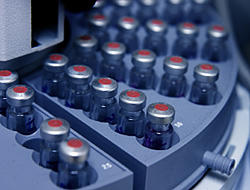
NIST researchers have developed methods and adapted techniques that will allow the pharmaceutical industry to monitor the formation of potentially dangerous aggregates in protein-based drugs.
Scientists at the National Institute of Standards and Technology (NIST) have developed a technique to measure the formation of clumps of proteins in protein-based pharmaceuticals. This first systematic study clarifies the conditions under which scientists can be assured that their instruments are faithfully measuring the formation of protein aggregates, a major concern because of its impact on quality control and safety in biologic drug manufacturing.
Proteins, a main constituent of many new drugs, are large molecules that have a tendency to stick to each other and form clumps during their manufacture. These clumps have been associated with severe immune responses. In at least one case, the inadvertent creation of protein clumps during the processing of a drug to treat anemia caused an immune reaction in about 250 patients that destroyed their ability to produce red blood cells. Those patients now have to receive blood transfusions every few days to replenish these vital cells.
Events such as this led the Food and Drug Administration to call for the development of sensitive and rapid measurement tools that can detect aggregation of protein drugs during the manufacturing phase. To address the problem, NIST researchers hit upon the idea of adapting a technique known as electrospray differential mobility analysis (ES-DMA). Commonly used to size soot and other aerosols, ES-DMA uses an electric current to vaporize a solution of proteins into tiny charged water droplets, each containing a single protein molecule or protein aggregate. Once these droplets evaporate, the charged proteins and protein aggregates are drawn into an oppositely charged tube. By making controlled adjustments to the voltage of the tube and the velocity of the air flowing through it, researchers can collect particles of a specific size, allowing the proteins and protein aggregates to be precisely sorted and counted.
The NIST team adapted the technique for biopharmaceutical applications. According to researcher Leonard Pease, ES-DMA is tricky to get right, but the NIST team was able to define the conditions needed to electrospray proteins and protein aggregates reliably and repeatedly. NIST scientists favor ES-DMA for its ability to quickly resolve particle sizes differing by as little as 0.2 nanometers, to provide a direct measure of particle size distributions, and to accept bioreactor samples with significantly reduced preparation requirements.
In addition to sizing proteins, Pease said the technique could also be used to accurately size many different types of particles used in medicine, such as the viruses used in the human papillomavirus (HPV) vaccine and gene therapy. "The adaptation of this technology is just one of many excellent examples of how NIST seeks out and works with U.S. industry," says Willie E. May, director of the NIST Chemical Science and Technology Laboratory.
L. Pease, J. Elliott, D. Tsai, M. Zachariah and M. Tarlov. Determination of protein aggregation with differential mobility analysis: application to IgG antibody. Biotechnology and Bioengineering. Available online at http://dx.doi.org/10.1002/bit.22017.

